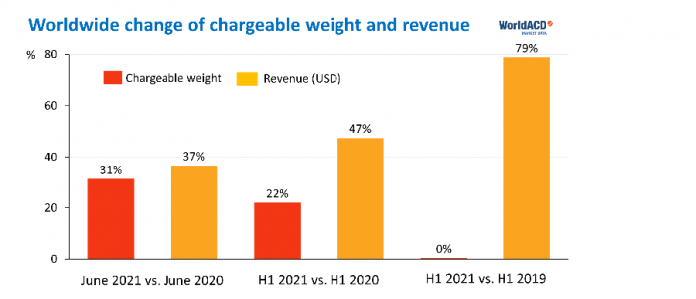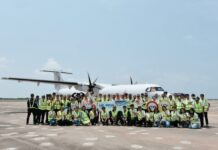

What a difference a year makes: comparing in detail air cargo’s performance for the first six months of 2019, 2020 and 2021 makes for fascinating reading, revealing how some market participants have done relatively well to extremely well, whilst others are not out of the doldrums yet.
The month of June 2021 confirmed the trend seen in the last few months: considerable volume growth over 2020 (this time 31%), coupled with an even larger YoY revenue growth (37% in USD). The MoM yield drop of 84 USD-cents between May and June 2020 (from 3.95 to 3.11) did not repeat itself: this year the difference between June and May yields was 14 USD-cents (from 3.37 to 3.23). Thus, June duly contributed to the YoY growth for the first six months of 2021: +22% in volume, +47% in airline revenues (in USD). But more importantly, worldwide air cargo volumes returned to the pre-pandemic levels of H1-2019 in the first six months of 2021. That is to say: in kilograms, for in revenues it outperformed H1-2019 by 79% (and H1-2020 by 47%).
Airlines
Airlines, grouped by region, contributed very evenly to the return to 2019-levels. The two exceptions were the African airlines as a group (+28% Yo2Y) and the Europeans (-5% Yo2Y). A striking pattern revealed itself when looking at yield developments: the airlines increasing their yields by more than 100% compared to H1-2019, all belong to the group of mid-sized and small airlines (in terms of cargo carried). All airlines, grouped by their home base, did better away from their home region than in the home region itself. It is not surprising that all groups did best in business growth from the origin Asia Pacific.
Forwarders
The world’s Top-20 forwarders consolidated their position as a group (Yo2Y), but there were interesting differences depending on the origins of the forwarders in this group. The top-forwarders from Europe did better than average comparing 2021 with 2020, but did not yet fully reach their 2019 market share. The top-forwarders hailing from Asia Pacific improved considerably, registering volume growth of 47% compared to 2020, and of 18% compared to 2019.
The regional Top-20 forwarders did better than the market in the smaller regions (Africa, C&S America and MESA), but lost considerable ground in Europe, benefiting the smaller forwarders.
GSAs
GSAs as a group did better than the market as a whole (Yo2Y): their growth was particularly strong in Asia Pacific, a region traditionally depending less than other regions on GSAs. In the traditionally strong “GSA-regions” (South America and MESA), we saw the opposite, as GSA’s lost in share of the total market. We observe that yields realised by GSA’s are on average about 10% lower than yields realised by airlines doing their own sales, but there are region-to-region markets where GSAs perform better.
Markets
WorldACD looked at the top-5 markets (country pairs) in five large origins, viz. Hong Kong, Japan, Germany, USA Atlantic South and China East. Three top-country pairs from Hong Kong, two from Germany, two from USA Atlantic South and one from Japan have not yet recovered, showing negative growth compared to 2019. On the other hand, the markets Japan – China East and China East – USA Midwest show a phenomenal growth around 50%; China East – USA Midwest is the market with a revenue growth of close to 250%.
Express air transport
Express air transport, normally used mainly for smaller shipments, expanded considerably over the past two years. Its total weight grew by 50% over 2019 and by 35% over 2020. Even more tellingly, the average size of express shipments went from 233 to 418 kgs in two years, thanks to the growth in e-commerce. The fact that the total air cargo weight worldwide is back at the 2019 levels, is completely thanks to the growth in the so-called weight break of >5,000 kgs per shipment. Weight in this category increased by 27% over 2019, whilst all smaller weight breaks showed a considerable decline.
Special cargo
Special cargo grew more than general cargo compared to 2019 (+2% vs. -1%), but less compared to 2020 (+16% vs. +25%). Whilst general cargo scored the highest yield/rate increase (in USD) over 2019 (+86%), in Special Cargo, only Pharma/Temp and Vulnerables/HighTech came close (+75% resp. +80%).
Judging by the provisional figures available for July, it seems likely that the present month will show a MoM yield increase of a few percentage points coupled with (seasonal) diminishing volumes.










